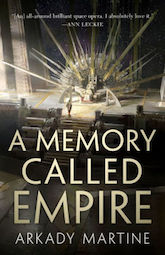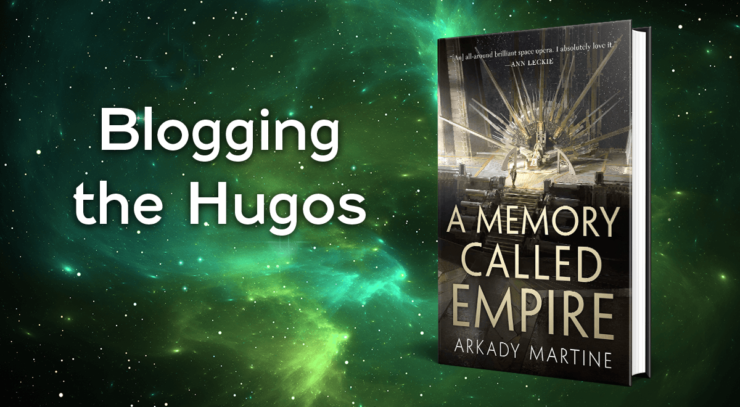In the lead-up to the 2020 Hugo Awards, we’re taking time to appreciate this year’s best novel Finalists, and what makes each of them great.
A Memory Called Empire, by occasional Tor.com contributor Arkady Martine (née historian AnnaLinden Weller) is one of my favorite kinds of science fiction books: the political thriller. That is to say, it is a political thriller pasted into a science fiction novel, or perhaps the other way around. Its story functions as an exploration of the politics of a future human society that feels sensibly extracted from that of our present day, plus cool spaceships and a dash of cyberpunk.
I like books like this because they usually have a lot to say about the world around us, but can do so with enough cool technological ornamentation that you might not notice if you aren’t paying attention, and that’s fine. A Memory Called Empire is a very, very good political sci-fi novel (not for nothing was it nominated for both the Hugo and the Nebula this year, one of a trio of debut novels to accomplish this particular feat in 2020). It takes place within a dominant future human empire known as Teixcalaan, which has control of a network of wormhole gates that have given it the means and the methods to absorb the cultures and resources of one human civilization after another (there are no on-the-page aliens to speak of in this space opera, though signs of a mysterious, unconfirmed alien presence encroaching on Teixcalaan space do kick the plot into gear). Our protagonist is Mahit Dzmare, ambassador to the Teixcalaan from the strategically located but otherwise unimportant Lsel Station, a self-sufficient outpost that is doing everything it can to avoid annexation by the empire.
The question of independence is a bit clouded as the novel opens, as Mahit is making her way to the Teixcalaan capital to replace her predecessor, Yskandr Aghavn, who has been incommunicado for 15 years and is also recently dead. With no knowledge of the alliances Yskandr had forged on the station—nor the enemies he’d made—Mahit’s position is a tenuous one from the outset, especially considering the Teixcalaan elite tend to view Lsel as a backwater and Mahit as an uncultured barbarian of sorts.
Buy the Book


A Memory Called Empire
What the Teixcalaan don’t know is the Lsel Station has maintained its independence for so long thanks to a remarkable bit of proprietary technology: the Imago, a small biomechanical device implanted near the brainstem that records the experiences, skills, and personality of its host, preserving them for implantation into another body and mind down the line. (It might help to think of it as a mix between Altered Carbon‘s cortical stacks and the Trill of Star Trek: Deep Space Nine.) Unfortunately, Mahit’s Imago of Yskander dates back to his last visit to Lsel Station, meaning the voice in her head can only offer so much help—and less than that, once the device stops working altogether for mysterious reasons.
The origin of the faulty Imago is but one of the mysteries that drives the plot. Another concerns the fate of Yskander himself: Did he die of natural causes, or due to lethal misadventure, or outright murder? Certainly there are plenty of suspects, for the Empire is in the midst of a succession crisis and various key players seem to have viewed Yskader as either a threat or a potential ally—or both. Minus the aid of her implanted predecessor, Mahit must rely on her cultural attaché, an ambitious young diplomat named Three Seagrass (Teixcalaan naming conventions are a delight I’ll let you discover for yourself), to keep her safe. Plots and counterplots pile atop one another as Mahit begins to unravel a conspiracy involving a potential civil war in which Lsel station may play a pivotal role.
As a feat of worldbuilding, it is playful and imaginative; the peculiar language and politics of the Teixcalaan Empire are massively interesting and enormously fun (try to finish the book without choosing your own Teixcalaan name), and are woven into the narrative so effortlessly that you won’t be bored by infodumps—nor will you strictly need to consult the appendix at the back (though I recommend doing so; it’s quite delightful). In particular, the clever epigraphs that open each chapter offer economical yet intriguing background on the history of this civilization. In the form of customs paperwork, a guidebook, a news transcript, a screenplay and more, they are amusing to read and doubly so to puzzle out—particularly because half of them pull from Teixcalaan sources and half from those of Lsel Station, and their accountings of the way of things don’t always agree.
As a narrative, it is drum-tight and perfectly paced. The plot starts off as a murder mystery and builds from there, the death of Mahit Dzmare’s ambassadorial predecessor turning out to be most consequential indeed, and for reasons I definitely did not see coming. There are many factions vying for power on Teixcalaan, and none of their motives are quite the same. But as complex as they are, the politics are never confusing, no mean feat in a book with so many characters and, yeah, I’ll say it, such challenging naming conventions (so maybe I did use the appendix a few times).
All this, and the characters are memorable too: Mahit’s is a comfortable mind to spend a few hundred pages inhabiting; she’s both incredibly competent and occasionally naive to a fault. The supporting cast is peppered with fascinating foils and allies who you’ll come to know and hate or love in appropriate measure (and weep for, on occasion; not everyone makes it out alive). I didn’t know there were plans for a sequel until I’d finished reading it, and I was delighted at the prospect, if only for the chance to see a few of these folks again.
I knew within a few chapters that A Memory Called Empire was going to be an impressive first novel, and my opinion of it only improved in the reading: It’s a nearly flawless one. It’s been a long time since I’ve read such a cohesive debut, so assured in terms of narrative voice, plotting, and character. It’s thematically rich, musing on the push and pull of colonialism and empire, power and exploitation, subjugation and interdependency. In short, I can’t think of much negative to say. I fairly loved it, and remain deeply impressed at the feats it accomplishes more than a year after reading it for the first time.
An earlier version of this post appeared in May 2020.
Joel Cunningham was the founding editor of the B&N Sci-Fi & Fantasy Blog (RIP), where he explored the galaxy for 5 years, picking up a Hugo Award (well, tangentially) along the way. He’s now managing editor of Lifehacker, which means he’s managing at least one thing nowadays. He lives in an apartment in Brooklyn with his wife and two children and hopes to go outside again someday. He tweets @joelevard.










